A final year project on “The Impact Of Training And Development On Employee Retention” was submitted by Shreya Sah (from Galgotias University Greater Noida, Uttar Pradesh) to extrudesign.com.
| University: | Galgotias University Greater Noida, Uttar Pradesh. | |
| Project Title: | The Impact Of Training And Development On Employee Retention | |
| Submitted by: | Shreya Sah | |
| Authors: | ShIvangi Kumari and Shreya Sah | |
| Supervised by: | Namrata Mishra, Asst. Professor | |
| Department: | Bachelor in Business Administration | |
| Academic Year: | 2021-22 |

ABSTRACT
An organization’s primary focus after recruiting talented employees is to retain them. But in today’s competitive environment, the organization is struggling hard to design a suitable strategy that could improve the retention rate and pulls the turnover rate downward. One such suitable strategy an organization could be considered of improving employee’s skills by providing training. The purpose of this paper is to examine the relationship between training and development on employee retention and ascertain the extent of influence of training and development on employee retention. The study was carried out by using a descriptive research design and adopted a stratified random sampling method to collect data. Results suggest that there is a relationship between training and development on employee retention and training has an impact on employee retention.
1. INTRODUCTION
Organization, and how great is the effect of training and development, which is a human resource practice that could have on employees’ commitment and retention as compared to other practices.
This research could provide a better understanding in the relationship of the effectiveness of Human resource practices on employee retention in an organization, but the main focus would be on the impact of training and development on employee retention. It will provide useful information regarding the impact that employee training has on employee retention. This study will help readers to better understand and will serve as a guide to many organizations regarding employee retention. It will also provide asolution using training and development practice to retain employees in organizations.This study has been initiated with an introduction, which includes the background of order to understand the other authors’ point of view about the impact of training on employees’retention. Hypothesis will be tested in some ways that could prove or disapproves it. Methodology for conducting the study and analysis techniques used to analyze the collected data has been discussed. At the end of the study results and conclusion has been discuss. Most researchers use these variables like working environment, training and development, and compensation to observe their effect separately, on how working environment affect employee turnover, how employee can be retained through training and development, and what are the impacts of compensation (Deckop et al.,2006; Acton and Golden 2003; Bhattacharyya et al.,2008). Few researchers also relate training and wages, in which they observe the effect of training on wage expectations (Renger, 2002; Hocquet, 1999; Dearden etal., 2005; Meer and Ringdal, 2009; Schùne, 2001;Renaud, 2009). No one focused on how employee can be retained after training, if they are not properly compensated. However, the effect of what will happen, if an employee is not properly compensated after his training, and whether he is satisfied or not and does not want to stay with the company, because after training his skills improved, is seen in this paper. As a consequence ,he has more opportunities of switching.
Literature Review
Conceptual Frame Work
Employee Retention
Employee retention can be defined as the policies and practices organizations use to avoid precious employees from quitting their jobs. However, Ben-Bakr, Al-Shammari, Jefri and Prasad (1994) argued that organizations can avoid business instability when talented employees are retained. Retention can be seen as the ability to hold onto those employees you want to keep, for longer than your competitors (Johnson, 2002, cited in Shaibu, Noor, Tirmizi & Bashir, 2009). Again, Denton (2000) puts forward the view about employee retention that employees who are contented and satisfied with their jobs are more devoted to their job and always put their effort to progress their organizational customers’ satisfaction. Researchers such as Taplin, Winterton, and Winterton (2005), Amadasu (2003) and Gberebie (2003) have established in their studies that, employees will surely stay and work for the flourishing and accomplishment of organizational goals if suitable employee retention strategies are adopted and implemented by organizations. In addition, Action and Golden (2003) state that retention of employees is not only important but retention of valued skills is more important. According to the researchers, the human resource department plays a dynamic role in the retention of employees.
Freyermuth (2007) commented that retention starts with the recruiting of correct individuals and continues with practising programs to keep them engaged and committed to the organization. According to him, it is considered a multifaceted component of an organization’s resource policies. Baker (2006) said that employee retention is very important because of the fact that hiring new employees are far more complicated as well as costlier than remaining with the present employees in the organization.
However, Olowu and Adamolekum (2005) stated that because of the need for effective and efficient delivery of goods and services by organizations in the public or private sector, it is becoming more essential to secure and manage the competent human resource as the most valuable resource of any organization. Gberebie (2008) has assured us that employee retention implementation strategies is very important. In today’s competitive environment there is a great need of employees’ commitment and an appropriate strategy that pulls the retention rate downward. Companies consider retention of employees as a challenge due to the increased flexibility of jobs. Various studies have been conducted that popular HR practices are not the only ways to enhance commitment and reduce retention. Scott Brum (2007) highlighted that when the employees are introduced to more training, they show a higher level of commitment as compared to others. Roya Anvari et al (2010) revealed that it is possible only with the help of planning training programs that are totally based on needs valuation to achieve commitment and retention. Training is considered important in developing a feeling of belongings among employees. Eva Kyndt et al (2009) revealed that training has the potential to change the turnover thoughts and is an important factor that helps in originating the intentions of turnover. Those employees that are highly committed to the organization have lower turnover thoughts. Training basically brings an association between commitment and retention. Danlami Sani Abdul Kadir et al (2012) have considered training as an investment, an organization bears the whole expenditures of training employees which eventually act as an investor and expects a return in the form of commitment and retention from employees. Training elevate commitment and retention rate when employees consider it as an investment and force them to offer a return to the organization. Alexandros G. Sahinidis and John Bouris (2007) Training is a long term investment in the skills of employees. Training is not a tool to polish the current skills of employees but to prepare employees for future impacts from competitive forces. This kind of training boosts the commitment and employees think that organization is opening doors to our success. This sense eliminates the thoughts or intentions to quit from employees’ mind and force them to retain. Mohammad I. Fheili (2007) has stated that employee turnover is a major human capital risk for an organization, which needs to be catered to. Organizations that provide training which is specific in nature applied only to the specific work within the organization make the employees specialists, not generalists. By doing this Organization limits the employment opportunities and leads to the development of committed employees and will eventually affect the retention rate.
OBJECTIVES OF STUDY
The main objective of the study is to critically examine the impact of training and development and development on employee retention in an organization. Specific objectives of the study are:
- To identify the factors affecting high employee turnover in an organization.
- To identify the effect of training and development, its type and duration on employee retention in an organization.
- To identify the extent by which management support and rewards affect employee retention.
SIGNIFICANCE OF THE STUDY
The study will help firms understand the importance of training and development programs. It will also enable them structure their training and development programs to make them more effective in terms of helping to improve the efficiency of the workforce and lead to less employee turnover. This also ensures the existence of a pool of skilled workforce who could be utilized for national development. Labour is a major input to the success of the company. If labour is efficient it will help improve the performance of the company. As companies perform better they are able to increase output and contribute more to the economy. They are also able to grow and hire more people thus helping to decrease the level of unemployment. As companies perform better, they are also able to compete better enabling the economy to remain vibrant.
The study will also be of great benefit to student researchers who wish to explore more into the impact training and development have had on the overall performance of employees in various organizations. The study will serve as a guide to these students who may further get more insights into the recommendations and findings from the study thereby, forming empirical literature for them
METHODOLOGY
The focus of this research was aimed at clarifying the impact of training on employee retention. The questionnaire was developed to collect data for determining the effect of the independent variable (training) on the dependent variable (retention). Quantitative data was collected through questionnaires using non-probability sampling. The questionnaire consists of 16 questions, which include eight questions on the independent variable (training) and nine questions on the dependent variable (retention). Questions asked from employees were based on a 5-points Likert scale. The collected data has been analyzed through the excel data analysis tool pack
POPULATION
The nature of research is linked more to employees and organizations. The target audience for this particular research is employees and people who worked but dissatisfaction with an organization and forced them to quit. The questionnaire has been filled by the employees of different public/private sector organizations. Many public/private organizations can use results, which are active in promoting learning and wanted to retain valuable employees. This research will make the organizations to think about the training’s impact on employee retention
SAMPLE
The sample size selected for data collection was 100, which includes 82% males and 18% females. Statistical analysis has been conducted on the responses collected from these 100 respondents. A convenience sampling technique was adopted to fill questionnaires from employees. The questionnaires are filled by public/private sector employees i.e. Schlumberger, National investment board, National rural support programme and Pakistan broadcasting corporation. The response rate was observed to be 100%.
VARIABLES
Two types of variables are used in this research. The dependent variable identified for research is retention while the independent variable is training.
DEPENDENT VARIABLE (RETENTION)
Retention has been considered as a factor, which has observed and measured the effect of the independent variables (training). Retention has been presumed to be the effect due to the cause of training. Responses related to retention from hundred respondents have been considered a dependent variable. Nine questions have been asked related to retention (dependent variable)
INDEPENDENT VARIABLE (TRAINING)
Training has been considered as a factor, which will examine the impact of training on employee retention. Training has been presumed to be the cause that will create an effect over retention. Eight questions have been asked related to training (independent variable).
DATA ANALYSIS TECHNIQUES
Three analysis techniques have been used to examine the relationship and significance between the independent variable (training) and the dependent variable (retention)
- Descriptive statistics
- Correlation
- Regression
THEORETICAL FRAMEWORK

The purpose of the research is to examine the effect of training opportunities on employee retention. Training is considered as an independent variable while employee retention is considered as a dependent variable. Organizational equilibrium theory by March and Simon’s states that employees who value acquiring new skills and polishing the existing one for their career growth maybe more willing to work for an organization who equips them with well-run knowledge. In organizations skills can be polished or developed through trainings, this theory clearly shows that there could be direct or indirect effect on training on employee retention. In indirect relationship, commitment could act as a bridge between training and employee retention.
Results and Discussion
Descriptive Statistics
| TRAINING | RETENTION | |
| Mean | 3.79 | 3.51 |
| Median | 3.8 | 3.5 |
| Standard Deviation | 0.4414 | 0.4746 |
| Minimum | 2.5 | 2.41 |
| Maximum | 4.6 | 4.41 |
| Count | 100 | 100 |
The calculated mean for the independent variable (training) is 3.79, which means that average people from a sample of 100 are somewhat satisfied. Since the value of 3.79 rounds off to 4, which is equal to somewhat agree. For the dependent variable (retention) the calculated mean is 3.51, which means that average people from a sample of 100 are somewhat satisfied. Since the value of 3.51 rounds off to 4, which is equal to somewhat agree. The median for the independent variable (training) is 3.8, and the value of the median for the dependent variable is 3.5. The median suggests option four of the questionnaire which is somewhat agreed and option three for retention which is average.
The standard deviation for the independent variable (training) is 0.44, and the standard deviation for the dependent variable (retention) is 0.47. This shows that the data of training is spread out at 0.44 and for retention, it is at 0.47
In the sample size of 100, the minimum value of an independent variable (training) is 2.5. This minimum value of 2.5 means that the minimum option selected by the respondents for the provision of training is somewhat disagreed. The maximum option selected by the respondents for the independent variable (training) is 4.6, which rounds to strongly agree. The minimum value of a dependent variable (retention) is 2.41. This minimum value of 2.5 means that the minimum option selected by the respondents for retention is somewhat disagreed. The maximum option selected by the respondents for the dependent variable (retention) is 4.41, which rounds to somewhat agree.
CORRELATION
| Training | Retention | |
| Training | 1 | |
| Retention | 0.5289 | 1 |
The correlation test has been conducted to express the strength of the relationship between training and retention on a scale from -1 to 1. The value of 1 has been considered a perfect correlation between variables. The value of correlation between training and retention is 0.5289, this value deviated more toward perfect correlation. This value indicates a positive relationship in which a change in training will produce a change in retention.
REGRESSION
| Coefficient | t-stat | |
| Intercept | 1.3583 | 3.862 |
| Training | 0.5668 | 6.1703 |
| R-square | 0.2708 | |
| F-stat | 38.0737 |
The regression test is conducted to determine whether there is evidence of a linear relationship between the provision of training to employees and their return in the form of retention. The regression equation for the data is y=1.3583+0.5688x. This means that for every single training opportunity, the retention rate has been increased by about 0.5688. The constant term in this equation is 1.3583. This is the y-intercept, and it means that if the independent variable i.e. training is 0, the value of the retention would be 1.3583. The R Square value is 0.2798; variation in the values of the retention that can be clarified by the change in the independent variable which is training has been measured. The R Square values vary between 0 to 1. A value of 0.2798 means that 27.98% of the variation in the retention rate is due to the provision of training to employees in organizations. The remaining 72.02% of the variation has been supposed to be due to other human resource practices like compensation, performance management system and working environment. The F ratio is 30.0737, which indicates that the regression is statistically significant. The p-value is displayed in the next column and equals 1.536E-08. This p-value is less than 0.05, the regression is statistically significant. The analysis shows that there is a significant impact of training on employee retention so, we reject the null hypothesis and accept the alternative hypothesis. T-stat is 3.8620 which is greater than 1.96 with significantly less than 0.05 indicating that there is significant relationship exists between the provision of training to employees and their retention. This t-stat value of 3.8620 also shows the independent variable.
Learning, T & D, retention and compensation
As commented by Srimannarayana (2011), training and development play an important role in retaining employees. If proper training is not given to them then they can’t develop. Compensating them with incorrect terms and giving them feedback will encourage them. The work environment is also an essential attribute that is required for retaining employees. It is considered as one of the most important aspects in the context of employee retention. Work environment is subjected important in this case as it the driving force behind a successful organization. For example, if the work environment is not suitable or uncomfortable for the employees, the productivity and the quality of the work will be affected. An effective organization is not only responsible for human capital but also to retain experienced and knowledgeable employees. The work environment is entailed effective as if the worker remains satisfied with his work environment, then he or she will continue to work in the present space positively. Having a positive perception in the context of the organization is very important and it can be adhered to by the appreciation of the employees. It will encourage and enhance the worker to perform better in every condition. The HR practices need to be high terms so that the employees stay longer and provide effective work. HR sources are good sources in context to the development of an organization and retaining employees.
Requirement and Need for Learning, Training and Development
Evaluating these elements can be done by the higher-level authority of the organization. They can monitor the work of their workers and give them feedback. Development and learning is not an instant process it can avail through experience. In this time of development, where innovation changes once in a while, training turns essential for each organization to stay in the worldwide market. Organizations can’t depend just on regular specialisms, however, to contend, later on, they should build up their worker abilities, since it is a time of efficiency and quality. As commented by Lundmark et al. (2017), training is described as the orchestrated mediation that is planned to improve the determinants of individual work execution. The organization suffers in quality and use in light of the nonappearance of training.
In a general sense, training began from changes grabbed by learning, notwithstanding the way that change is critical for human improvement. In this promising authoritative reality for survival, an organization must be furnished with properties of flexibility, versatility, and unending quality. With these qualities, the survival of an organization can be practised through training and advancement of its workers. It is generally related to the present spot of work and the nonstop situation. Of course, advancement is the path toward creating future businesses. Training must be need-based; appropriately, the firm needs to, first, do the assessment on account of whether training is required or not. Consequently, comprehensive training needs performed the assessment, which exhibits why and where the preparation is required, and besides observing which worker needs training and who should be set up for improvement reasons. Now and again, training isn’t incredible, the firm gives unequivocal training to the workers since these capacities were not totally traded to them. Along these lines, it is neither productive for the specialist nor for the organization.

Practical implications and recommendations
The results of this research will be useful for organizations to understand that training practice could be shaped into a retention strategy. Research explores the perception of employees about the training practice of an organization when employees are interested to stay with an organization. There could be a possibility that if the organization fulfils the employee’s needs regarding polishing existing skills and preparing them for upcoming challenges, the retention rate will be boosted. This research can help the organization to build a reputation as a learning organization; it will become a favourite organization for people who are employed. The future recommendation is that researchers can study the impact of training on employee retention, but try to explore other factors that can affect retention along with training. Researchers can compare the results of training against other human resource practices that can retain employees.
Data Analysis
Quantitative Analysis
Q1. What is your gender?
| Respondents | Variables | Percentage |
| Male | 35 | 35 |
| Female | 65 | 65 |

The higher side than those of the males who constitute only 35% of the total respondents. The female respondent’s percentage has emerged to be of 65 %. It can be understood in a better way by the diagrammatic representation of the data chart in the form of a pie diagram. In which it shows that the first quarter reflects the total percentage of the female respondents whereas the second quarter represents the male respondent’s percentage.
Q2. What is your educational qualification?
| Respondents | Variables | Percentage |
| Matriculation | 20 | 20 |
| Under Graduate | 10 | 10 |
| Graduate | 40 | 40 |
| Post – Graduate | 20 | 20 |
| Doctorate | 10 | 10 |
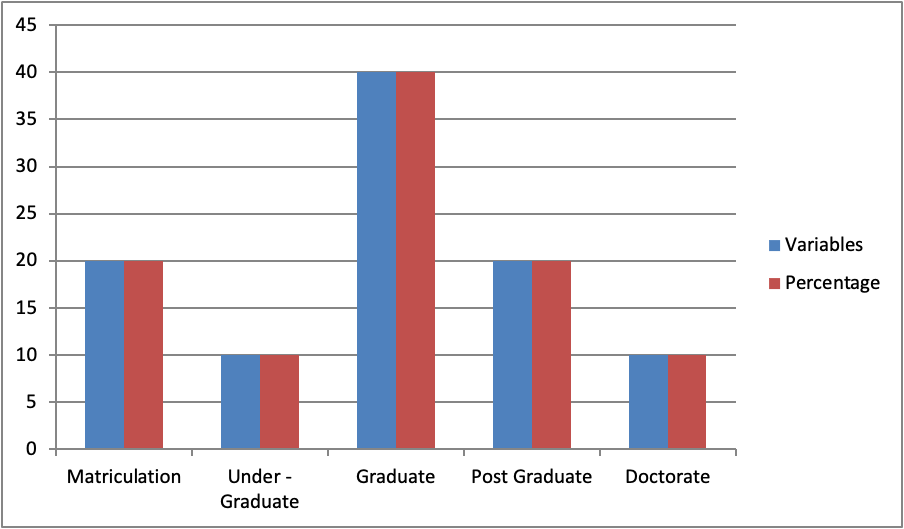
The researcher took 100 respondents to impart in this study. The respondents were chosen so that the data obtained can help the ongoing results of the research. To ensure that the results obtained are correct the reality of the data has been checked and then presented in the below format. In this above-mentioned chart, the researcher shows a total of 100 respondents on which the study has been conducted under the question based on education qualification. It is very much evident from the above table that matriculation respondents resemble 20%, undergraduate resembles 10%, graduate resembles 40%, post-graduate resembles 20% and doctorate resembles 10%. It can be understood in an efficient way through the representation of bar diagram.
Q3. What is your monthly income?
| Monthly Salary (Rupees) | Number of Respondents | Percentage |
| Below $2000 | 30 | 30 |
| $2000 – $5000 | 20 | 20 |
| $5000 – $7000 | 25 | 25 |
| Above $7000 | 25 | 25 |
The researcher took 100 respondents to impart in this study. The respondents were chosen so that the data obtained can help the ongoing results of the research. To ensure that the results obtained are correct the reality of the data has been checked and then presented in the below format. In this above-mentioned chart, the researcher shows a total of 100 respondents on which the study has been conducted under the question based on the monthly income of the population. It is quite evident from the chart that the monthly income of the respondents below $2000 is 30. Of the respondents with $2000-$5000 are 20. The respondents with a monthly income of $5000-$7000 are 25. The respondents above $7000 are 25. The percentage of the respondents in context to0 the monthly salary is 30%, 20%, followed by 25% and then 25%.

Q4. Does the training program enable the employees to be accountable and authoritative in making decisions?
| Respondent | Variables | Percentage |
| Strongly agree | 11 | 11 |
| Agree | 55 | 55 |
| Neutral | 29 | 29 |
| Disagree | 2 | 2 |
| Strongly disagree | 3 | 3 |
The researcher took 100 respondents to impart in this study. The respondents were chosen so that the data obtained can help the ongoing results of the research. To ensure that the results obtained are correct the reality of the data has been checked and then presented in the below format. In this above-mentioned chart, the researcher shows a total of 100 respondents on which the study has been conducted under the question based on whether training programs enable employees to be accountable and authoritative in making a decision. It has been seen that 55% of respondents agree with this fact and 2% of respondents disagreed with this fact. The respondents who strongly agreed with this fact were 11% whereas the respondents who were neutral were 29%. The respondents who strongly disagreed with this fact were 3%. Decision making is a very important attribute that every employee needs to adhere to. So training programs can definitely be subjected to induce the performance rate of the employees. However, it can be seen that 55 per cent of the respondents have agreed to the fact that training programs are imparted to make them, better and work effectively.
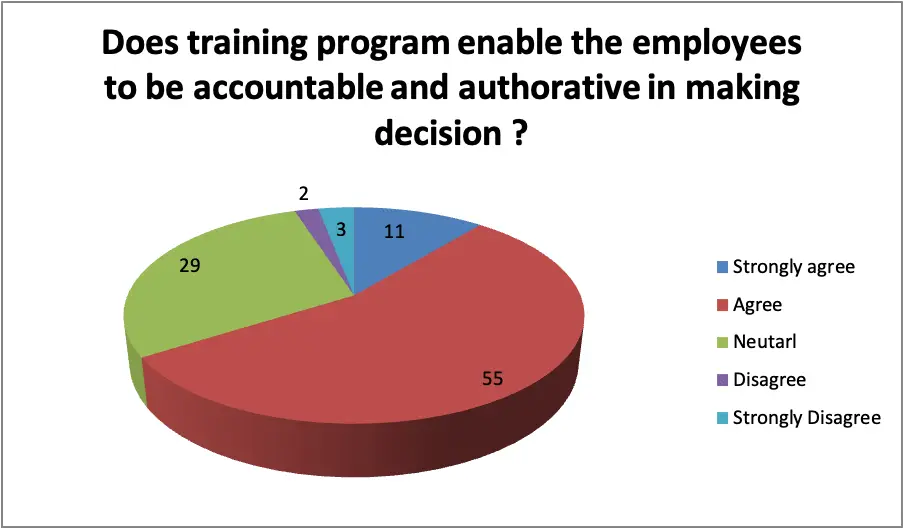
Q5. Does your organisation emphasizes and provides for the required training and development of its employees for better employee retention?
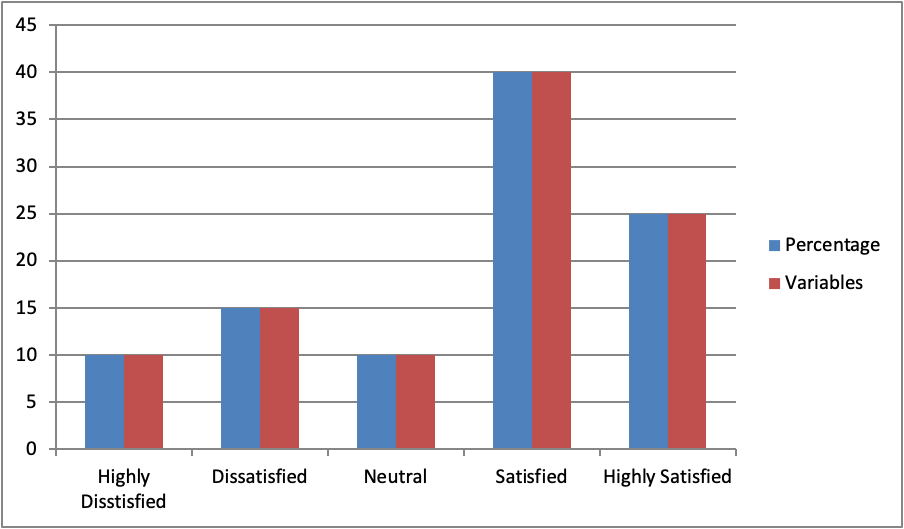
The researcher took 100 respondents to impart in this study. The respondents were chosen so that the data obtained can help the ongoing results of the research. To ensure that the results obtained are correct the reality of the data has been checked and then presented in the below format. In this case, the respondents were asked if the organization emphasizes and provides for the required training and development of its 6. employees for better employee retention. The reaction of the respondents related that the percentage of satisfied respondents was 40% whereas 10% 0of the respondents were highly dissatisfied. 25% of the respondents were highly satisfied whereas 15% of the respondents were dissatisfied. 10% of the population.
Q6. Do your employees find the training provided to them relevant to their job?
| Respondent | Variable | Percentage |
| Highly Satisfied | 10 | 10 |
| Satisfied | 30 | 30 |
| Neutral | 40 | 40 |
| Dissatisfied | 10 | 10 |
| Highly dissatisfied | 10 | 10 |
The researcher took 100 respondents to impart in this study. The respondents were chosen so that the data obtained can help the ongoing results of the research. To ensure that the results obtained are correct the reality of the data has been checked and then presented in the below format. In this case the respondents were asked if the employees find the training provided to them is relevant to their job. The reaction of the respondents related that the percentage of satisfied respondents was 30% whereas 10% of the respondents were highly dissatisfied. 10% of the respondents were highly satisfied whereas 10% of the respondents were dissatisfied. 40% of the population was neutral in this case.
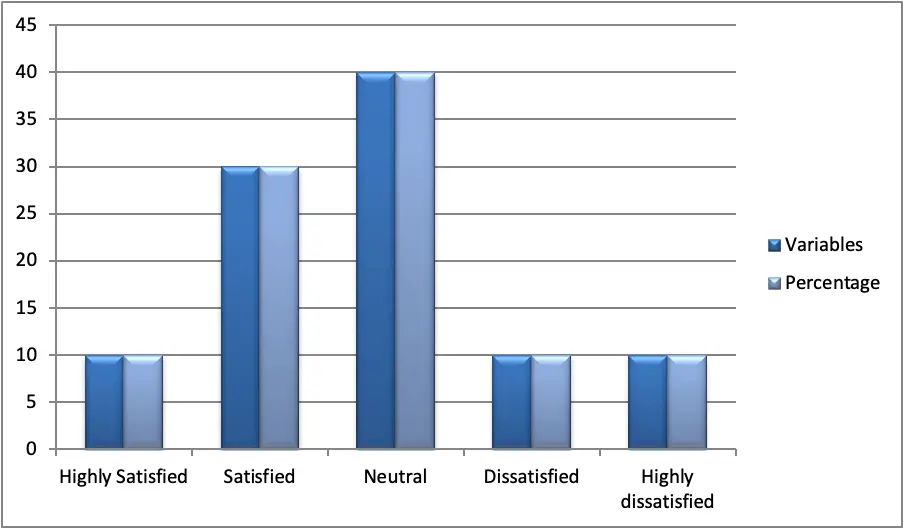
Q7. Do frequent training and development programs help retain the employees?
| Respondent | Variable | Percentage | |
| Highly Satisfied | 11 | 11 | |
| Satisfied | 55 | 55 | |
| Neutral | 29 | 29 | |
| Dissatisfied | 2 | 2 | |
| Highly dissatisfied | 3 | 3 |
The researcher took 100 respondents to impart in this study. The respondents were chosen so that the data obtained can help the ongoing results of the research. To ensure that the results obtained are correct the reality of the data has been checked and then presented in the below format. In this case the respondents were asked if Do Frequent Training and Development programs help retain the employees. The reaction of the respondents related that the percentage of satisfied respondents was 55% whereas 3% of the respondents were highly dissatisfied. 11% of the respondents were highly satisfied whereas 7% of the respondents were dissatisfied. 29% of the population were neutral in this case. In this context, it has been evident that 55% of respondents had been satisfied with the fact that training and development adhered by the organization motivate them to work effectively.
Q8. Do you think Training and development programs increase the efficiency in retaining the employees?
| Respondent | Variable | Percentage |
| Yes | 80 | 80 |
| No | 20 | 20 |
The researcher took 100 respondents to impart in this study. The respondents were chosen so that the data obtained can help the ongoing results of the research. To ensure that the results obtained are correct the reality of the data has been checked and then presented in the below format. In this case, the respondents were asked if the training and development program increases the efficiency in employees. The reaction of the respondents related that the percentage imparted that 80% of the respondents believed in the fact that training and development increase the efficiency in retaining the employees. If the employees are given proper training then they can conduct their given work in an effective manner, this will also help to increase the productivity ad effectiveness of the organization. 20% of the respondents thought that training and development do not increase the efficiency of the organization.
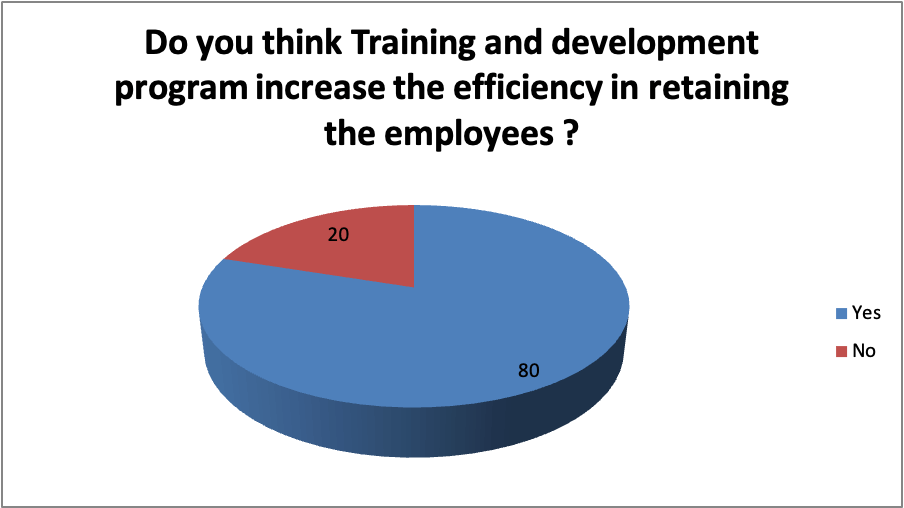
CONCLUSION
As the research has shown, there is a significant impact of training on employee retention. The research provides empirical evidence that supports the cause of training and its effect on employee retention. Researchers who examined the relationship between training and employee retention, agree that the relationship exists between these two variables. Research has proved that employees’ decisions to stay for a longer period of time can be influenced by training.
BIBLIOGRAPHY
- Abdulkadir, D. et al., 2012. Effects of Strategic Performance Appraisal, Career Planning and Employee Participation on Organizational Commitment: An Empirical Study. International Business Research, 5(4), 124-133.
- Abdullah, R., 2011. The study of employee satisfaction and its effects on loyalty in hotel industry. International Journal of Business and Social Science,
- Ahmad, K., 2011. Person-Environment Fit: The Missing Link in the Organizational Culture -Commitment Relationship. International Journal of Business and Management,
- Aldamoe, F. et al., 2011. The Mediating Effect of HRM Outcomes (employee retention) on the Relationship between HRM Practices and Organizational Performance. International Journal of Human Resource Studies,
- Anis, A., 2011. Employee retention relationship to training and development: A compensation perspective. African Journal of Business Management
- Anvari, R. et al., 2010. Personal Needs Assessment Approach in Strategic Training and Affective Commitment. International Journal of Business and Management
- Anvari, R. et al., 2011. Strategic training practices and turnover intention: The mediating role of organizational commitment. International journal of business and management studies,
- Brum, S., 2007. What impact does training have on employee commitment and employee turnover? Schmidt Labor Research Center Seminar Research Series
- Bussell, J., 2008. Great Expectations: Can Maternity Coaching affect the Retention of Professional Women. International Journal of Evidence-Based Coaching and Mentoring
- Dysvik, A. & Kovacs, B., 2008. The relationship between perceived training opportunities, work motivation and employee outcomes. International Journal of Training and Development
- Fheili, M., 2007. Employee turnover: an HR risk with firm-specific context. Journal of Operational Risk, 2(3), 69-84.
- Gberevbie, D., 2010. Organizational retention strategies and employee performance of Zenith Bank in Nigeria. African Journal of Economic and management studies
Credit: This final year project on “The Impact Of Training And Development On Employee Retention” was completed by ShIvangi Kumari and Shreya Sah under the supervision Of Namrata Mishra, Asst. Professor from Galgotias University Greater Noida, Uttar Pradesh.

Leave a Reply